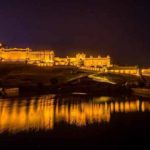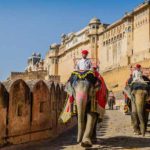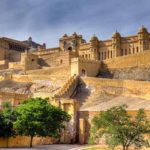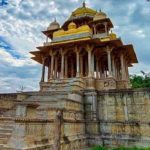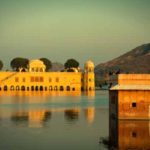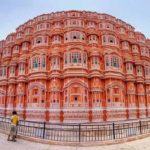11. Chittorgarh Fort, Chittorgarh

Chittorgarh Fort is an acknowledgement to the courage of the gallant Rajput rulers who sacrificed their life combating dominant rivals instead of surrendering before them. Chittorgarh Fort is said to have been the capital of the Guhilots and Sisodia kings beside other dynasties who ruled Mewar between the eighth and the sixteenth centuries.
The fort was attacked three times and every time it got saved by the daring heroism of the Rajput warriors. In 1303, for the first time, this fort was attacked by Allaudin Khilji said to fulfill his desire to make off with Rani Padmini. For the second time, the Fort was sacked by Sultan Bahadur Shah of Gujarat in 1535. In 1567, it was attacked for the last time by Mughal Emperor Akbar to conquer Maharana Udai Singh. Every time, a jauhar (mass suicide) was observed and the women folk of the Royalty never submitted themselves. This colossal fort is accessible through seven huge gates (Pols) that are comprised of strong iron spikes and served as a watch tower in earlier times.
The way to Chittorgarh Fort will take you through crisscross paths that would be interrupted at intervals by seven giant pols (gateways). The foremost gate you will come across is the ‘Ram Pol’ (the gate of Lord Rama) that has a temple in its vicinity. While climbing further, you would find two cenotaphs near Padal Pol. These cenotaphs are dedicated to Jaimal and Kala, who were killed by Akbar in the battle of 1567. Its eventful history and rich monumental heritage is characterized by strong fortification, gateways, bastions, palaces, temples, towers and reservoirs which are fine examples of Rajput architecture.
12. Vijay Stambh Chittorgarh

Vijay Stambh, established by Maharana Kumba in Chittorgarh is a nationalistic masterwork built to remember the triumph of the kingdom over the trespasser Mohammed Khilji. Constructed between 1442 AD and 1449 AD, this ‘Victory Tower’ commemorate King Rana Kumbha victory over joint armies of Malwa and Gujarat which was led by Khilji.
The tower is adorned memorably with Hindu God and Goddess. It is dedicated to Lord Vishnu. Vijay Stambh is a 9 story tower with a height of 37.19 mtr. Made with red sand stone and white marble, this tower has a balcony in each stories. Filled with inscriptions, images of wepons, musical instruments etc, this tower also has the portrait of Jaita, architect of this tower with his 3 sons – Napa, Puja and Poma. Tower is one of the most attractive part in Chittorgarh Fort.
13. Kumbhalgarh fort Kumbhalgarh

Kumbhalgarh Fort is a Mewar fort built on the Aravalli Hills, in the Rajsamand District of Rajasthan. Kumbhalgarh is the birthplace of Maharana Pratap, the great king and warrior of Mewar. The fort was constructed and expanded in the course of the 15-19th century by Rana Kumbha. Occupied until the late 19th century, the fort is now open to the public and is spectacularly lit for a few minutes each evening. The Kumbhalgarh fort is the second largest wall in the world after the Great Wall of China. It was constructed by Rana Kumbha between 1443-1458 A.D. The fort has ten gates and several temples dedicated to Hindu and Jain God. The Kumbhalgarh Fort is an unparalleled fort in the state of Rajasthan owing to its strategic location on the Aravalli, and the strong fortification wall built around it.
14. City Palace Udaipur

The City Palace stands tall over Pichola Lake, having served as an abode for the ruling royalty. Construction was begun by Maharana Udai Singh and was continued by successive Maharanas who incorporated several palaces and structures to the complex. Interestingly, each addition preserved the original style of the design. Visitors enter the palace through Bari Pol (the Big Gate) which leads one to Tripolia (the Triple Gate) where it was once a custom to distribute the Maharaja’s weight in gold and silver to his subjects. It now serves as the main ticket office. The palace has numerous balconies, cupolas and towers that overlook Pichola Lake. The structure is just as beautiful inside as it is spectacular from the outside. Each palace is designed in a unique way, and decorations like mirrored tiles, paintings, glass work and ornamental tiles bring to life the opulence of the era. Today, the main section of the palace has been converted into a museum that houses a large collection of artifacts.
15. Jag mandir Udaipur
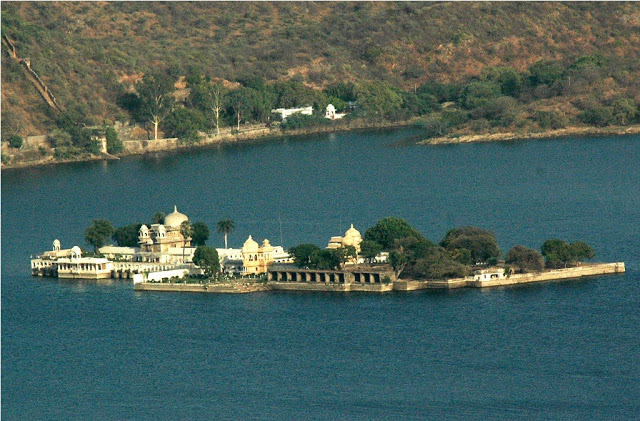
Jag Mandir is a palace built on an island in the Lake Pichola. It is also called the “Lake Garden Palace”. The palace is located in Udaipur city in the Indian state of Rajasthan. Its construction is credited to three Maharanas of the Sisodia Rajputs of Mewar kingdom. The construction of the palace was started in 1551 by Maharana Amar Singh, continued by Maharana Karan Singh (1620–1628) and finally completed by Maharana Jagat Singh I (1628–1652). It is named as “Jagat Mandir” in honour of the last named Maharana Jagat Singh. The royal family used the palace as a summer resort and pleasure palace for holding parties. The palace served as a refuge to asylum seekers on two separate occasions.
16. Nakki Lake Mountabu
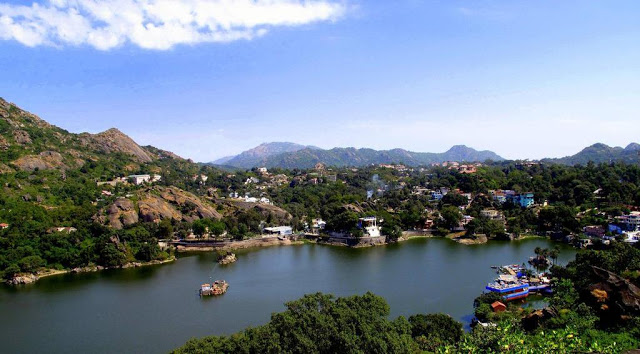
Nakki Lake in Mount Abu truly defines romance in Rajasthan. Named as Love Lake of Mount Abu, it is also a largest manmade lake at the height of 11,000 meters in India. It is also a sacred lake for the Garacia tribe of Rajasthan and at the time of their festival in Shukla paksha which falls in April month it is the place of worship and remembrance of their ancestors. People consecrate their nails in the lake on this festival. It is the reason for naming of this lake as ‘Nakki’.
17. Dilwara temples Mountabu

The Dilwara temples of India are located about 2½ kilometres from Mount Abu, Rajasthan’s only hill station. These Jain temples were built by Vastapul Tejpal , a Jain laymen between the 11th and 13th centuries AD and are world-famous for their stunning use of marble. The five legendary marble temples of Dilwara are a sacred pilgrimage place of the Jains. Some consider them to be one of the most beautiful Jain pilgrimage sites in the world. The marble temples have an opulent entranceway, the simplicity in architecture reflecting Jain values like honesty and frugality. The temples are in the midst of a range of forested hills. A high wall shrouds the temple complex. Although the Jains built some beautiful temples at other places in Rajasthan, some believe that none come close to these in terms of architectural perfection.
The ornamental detail spreading over the minutely carved ceilings, doorways, pillars and panels is simply marvellous. Facilities are available for bathing, which is mandatory before puja is performed for the idols. These facilities use passive solar power to heat up the water for bathing and other things. Guided tour hours for tourists are posted outside the temple.
18. Ranakpur Jain Temple, Ranakpur
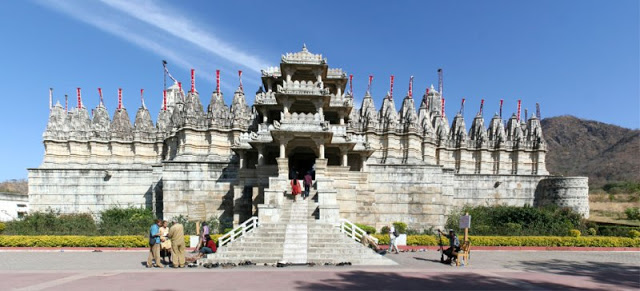
Ranakpur is one of the five most important Jain pilgrimage sites of India. The Jain temples in this town are dedicated to Lord Adinath, who was the first Jain Tirthankara. The most popular of the Jain temples present in the place includes the Chaumukha Temple. The Ranakpur Jain temple was built in 15th century AD, during the rule of Rajput monarch, Rana Kumbha.
The Jain community and their temples built in the place, were patronized by the ruling Mewar Dynasty. I is said that, Dhanna Shah, the founder of these temples, received land form Rana Kumbha, for building this temple. These temples are 500 years old, but are still in good condition and are well preserved. The basement of this temple is spread over a total area of 48,000 sq ft, covering the whole complex. The complex of this temple comprises four subsidiary shrines, along with 29 pillared halls and 80 domes that are supported by 1444 pillars, all intricately carved. The carvings on these pillars are present at a height of 45 ft and include pictures of nymphs playing flute and in various dance postures. In its assembly hall, there are two big bells weighting 108 kg each, whose sound echoes in the hall when being rung.
The complex of Chaumukha Temple consists of several other Jain temples like the temple of Parshvanath. This temple was built in the 15th century AD and is known for its engraved windows embellished with Jain figures. Near to this temple, there are two more temples out of which one is dedicated to Neminath, who was the 22nd Jain Tirthankara and the other one is dedicated to the Sun God.
19. Mehrangarh Fort Jodhpur

Mehrangarh Fort, Jodhpur is one of the largest forts in forts. It is also the most magnificent fort in Jodhpur, infact, in the whole Rajasthan. The fort is amongst the popular tourist places in India. It is situated on a 150 m high hill. It was founded by Rao Jodha in 1459. Other attractions of Mehrangarh Fort, Rajasthan include several palaces inside the fort, with their sprawling and huge courtyards. One of the fort’s palaces, The Moti Mahal or the Pearl Palace, has the royal throne of Jodhpur, the Sringar Chowki. The fort also has galleries, temples, etc. To the left of the Mehrangarh Fort is the Chhatri of a soldier, Kirat Singh Soda. It is the spot where he fell while defending the fort against the armies of Amber.
20. Umaid Bhawan Palace, Jodhpur

Umaid Bhawan Palace, located at Jodhpur in Rajasthan, India, is one of the world’s largest private residences. A part of the palace is managed by Taj Hotels. Named after Maharaja Umaid Singh, grandfather of the present owner Gaj Singh of the palace, this edifice has 347 rooms and serves as the principal residence of the erstwhile Jodhpur royal family. A part of the palace also houses a museum. Umaid Bhawan Palace was called Chittar Palace during its construction due to use of stones drawn from the Chittar hill where it is located. Ground for the foundations of the building was broken on 18 November 1929 by Maharaja Umaid Singh and the construction work was completed in 1943. The Palace was built to provide employment to thousands of people during the time of famine.

